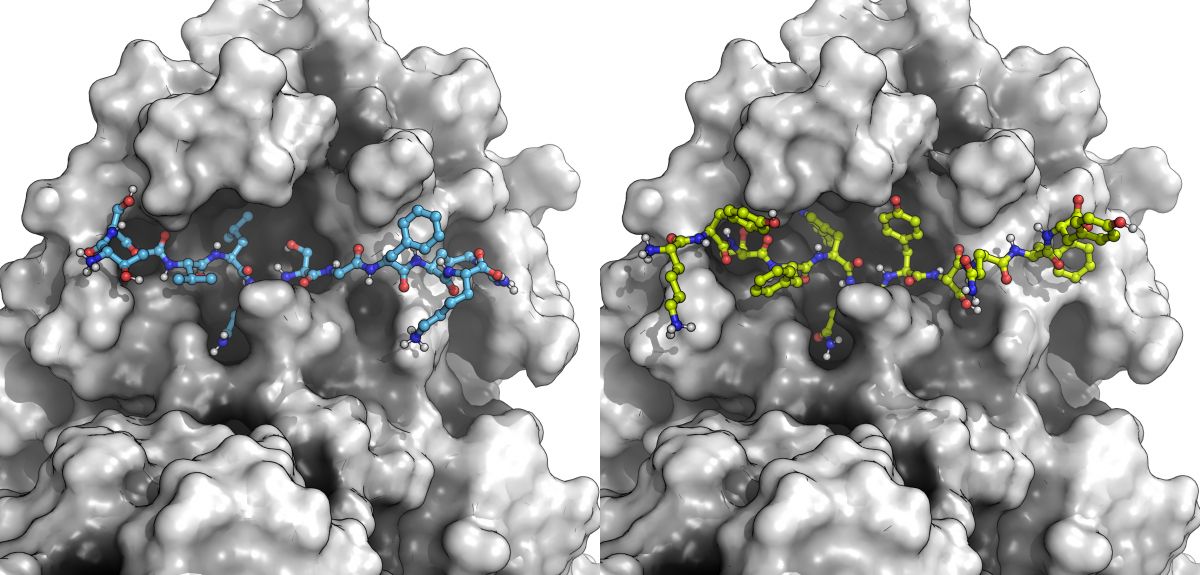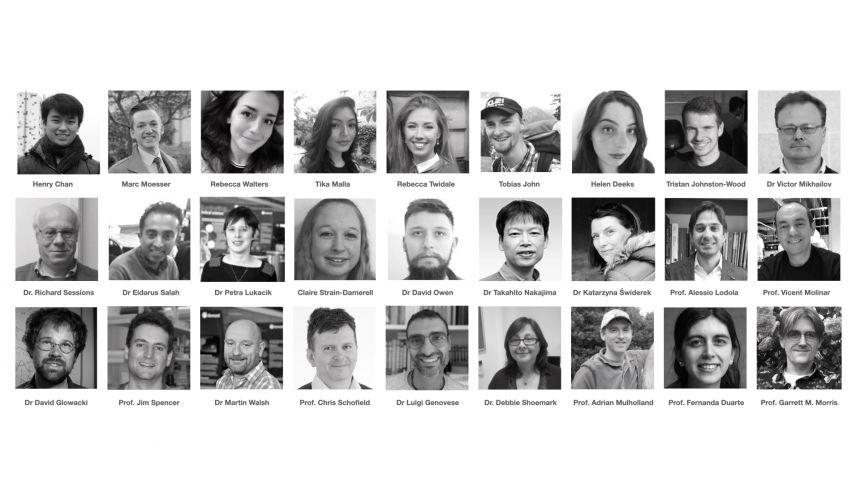
A unique international ‘zoom’ collaboration to develop treatments for COVID-19
In March 2020, the World Health Organization declared a global COVID-19 pandemic and the UK announced a strict national lockdown. When Oxford University scientists were sent home, they rolled up their sleeves, switched on their computers and started to help develop new drugs to target SARS-CoV-2, the virus that causes COVID-19.
‘What is remarkable about this collaboration, involving 29 scientists from around world, is that every meeting was entirely virtual, with many collaborators yet to meet face-to-face.’ Prof. Garrett M. Morris, Oxford University.
It began with a small group of scientists and their graduate students at the University of Oxford, who were joined by colleagues from Bristol University, Diamond Light Source and academics in France, Italy, and Spain – all working from home but coming together weekly on Zoom to tackle this terrifying disease.
Thus began an international collaboration involving 29 scientists around the world focused on understanding how SARS-COV-2 makes its worker proteins at the molecular level so we could develop novel antiviral drugs and block their production.
‘This collaboration has really shown how sharing of models, data and expertise can help get answers and understanding much more quickly. It’s how science should be done – particularly in the face of pressing problems like the Covid pandemic.’ Prof. Adrian Mulholland, Bristol University
Despite the development of successful vaccines in record time, there are no drugs that have been designed specifically to target COVID-19, but they are desperately needed.
Once SARS-CoV-2 has invaded a healthy human cell, the virus's own genetic material commandeers the infected cell's machinery, forcing it to make new copies of the virus.
The new virus begins as one long protein that cuts itself into functional units. First the cutting catalyst or 'protease' cuts itself out, which then cuts at multiple other positions.
‘The opportunity to apply our basic science on enzymes to a problem of enormous societal value in a fantastically collaborative manner was a wonderful life experience.’ Prof. Chris Schofield, Oxford University.
SARS-CoV-2 has two molecular machines or proteases that resemble 'molecular scissors'. One of these, called the main protease, or 'Mpro' for short, cuts at no less than 11 of these cut sites.
If scientists can design new molecules that bind more tightly than these natural substrates, they could stop the virus dead in its tracks. Blocking the cutter stops the virus from replicating—a strategy that has worked for treating other viral diseases like HIV and hepatitis.
Using 3D structures obtained by shining X-rays onto crystals of the main protease of SARS-CoV and SARS-CoV-2, Prof. Morris and his collaborators were able to develop computational models of how the SARS-CoV-2 Mpro binds to its 11 cut sites. From these models, they were able to gain key insights into how these viral Mpro 'molecular scissors' work.
Building on this knowledge, and using computational methods, they next sought to design novel molecules that could bind even more tightly than the natural cut sites. Using computers to sift through just over 200 trillion possibilities, they proposed new molecules that would stop the virus from maturing.
‘This experience taught me that science can be carried out regardless of working conditions, when a group of enthusiastic and motivated people gather together’. Luigi Genovese, CEA France.
All 11 cut sites and 4 of these designed peptides were synthesized and tested in the laboratory of Prof. Chris Schofield in the Chemistry Research Laboratory at the University of Oxford. The experiments showed that the novel designed peptides not only bound to the molecular scissors but blocked the substrates and actually inhibited the Mpro.
Scientists also carried out an extensive analysis of hundreds of published 3D structures of small molecules bound to Mpro and predicted how inhibitors designed by the COVID Moonshot would bind, figuring out how these 'molecular keys' fitted into the 'molecular lock' of Mpro, and using these insights to propose how to design new drugs to treat COVID-19.
‘Ironically, the busiest time of my PhD was when I was sitting at home during lockdown, working on the collaboration. The weekly, big zoom meetings created a great structure in an otherwise monotonous ‘lockdown-life’ schedule.’ Marc Moesser, Department of Statistics, Doctoral Student.
The team combined their expertise, applying a wide range of computational modelling techniques to build a complete picture of SARS-CoV-2 Mpro.
Much of the work was carried out by four graduate students: Henry Chan, Marc Moesser and Tika Malla at Oxford University, and Becca Walters at Bristol University.
These techniques ranged from comparative molecular modelling, molecular dynamics, interactive molecular dynamics in virtual reality, quantum mechanics, computational peptide design, protein-ligand docking, protein-peptide docking, to protein-ligand interaction analysis.
The team included: Prof. Garrett M. Morris (Department of Statistics), Prof. Fernanda Duarte, and Prof. Chris Schofield (Department of Chemistry) from the University of Oxford; Prof. Adrian Mulholland, Dr. Debbie Shoemark, Dr. Richard Sessions, and Prof. James Spencer from the University of Bristol, UK; Prof. Martin Walsh from Diamond Light Source, U.K. and Dr. Luigi Genovese of the CEA (Atomic Energy Commission) in France; and Prof. Alessio Lodola from the University of Parma, Italy, and Prof. Vicent Moliner and Dr. Katarzyna Świderek from the University of Jaume I, Spain joining the team as the project progressed.
The report, 'Discovery of SARS-CoV-2 Mpro Peptide Inhibitors from Modelling Substrate and Ligand Binding', has just been published in the Royal Society of Chemistry's flagship journal, Chemical Science.
 Some of the Scientists investigating SARS-COV-2 who only met virtually
Some of the Scientists investigating SARS-COV-2 who only met virtually Africa’s change-makers: meet the Mastercard Foundation Scholars with big ambitions for the future
Africa’s change-makers: meet the Mastercard Foundation Scholars with big ambitions for the future A green fuels breakthrough: bio-engineering bacteria to become ‘hydrogen nanoreactors’
A green fuels breakthrough: bio-engineering bacteria to become ‘hydrogen nanoreactors’ Oxford's student voices at COP29
Oxford's student voices at COP29 Teaching the World’s Future Leaders
Teaching the World’s Future Leaders  A blueprint for sustainability: Building new circular battery economies to power the future
A blueprint for sustainability: Building new circular battery economies to power the future Oxford citizen science project helps improve detection of antibiotic resistance
Oxford citizen science project helps improve detection of antibiotic resistance The Oxford students at the forefront of the fight against microbial resistance
The Oxford students at the forefront of the fight against microbial resistance  The hidden cost of AI: In conversation with Professor Mark Graham
The hidden cost of AI: In conversation with Professor Mark Graham  Astrophoria Foundation Year: Dr Jo Begbie reflects on the programme’s first year
Astrophoria Foundation Year: Dr Jo Begbie reflects on the programme’s first year